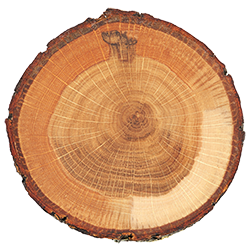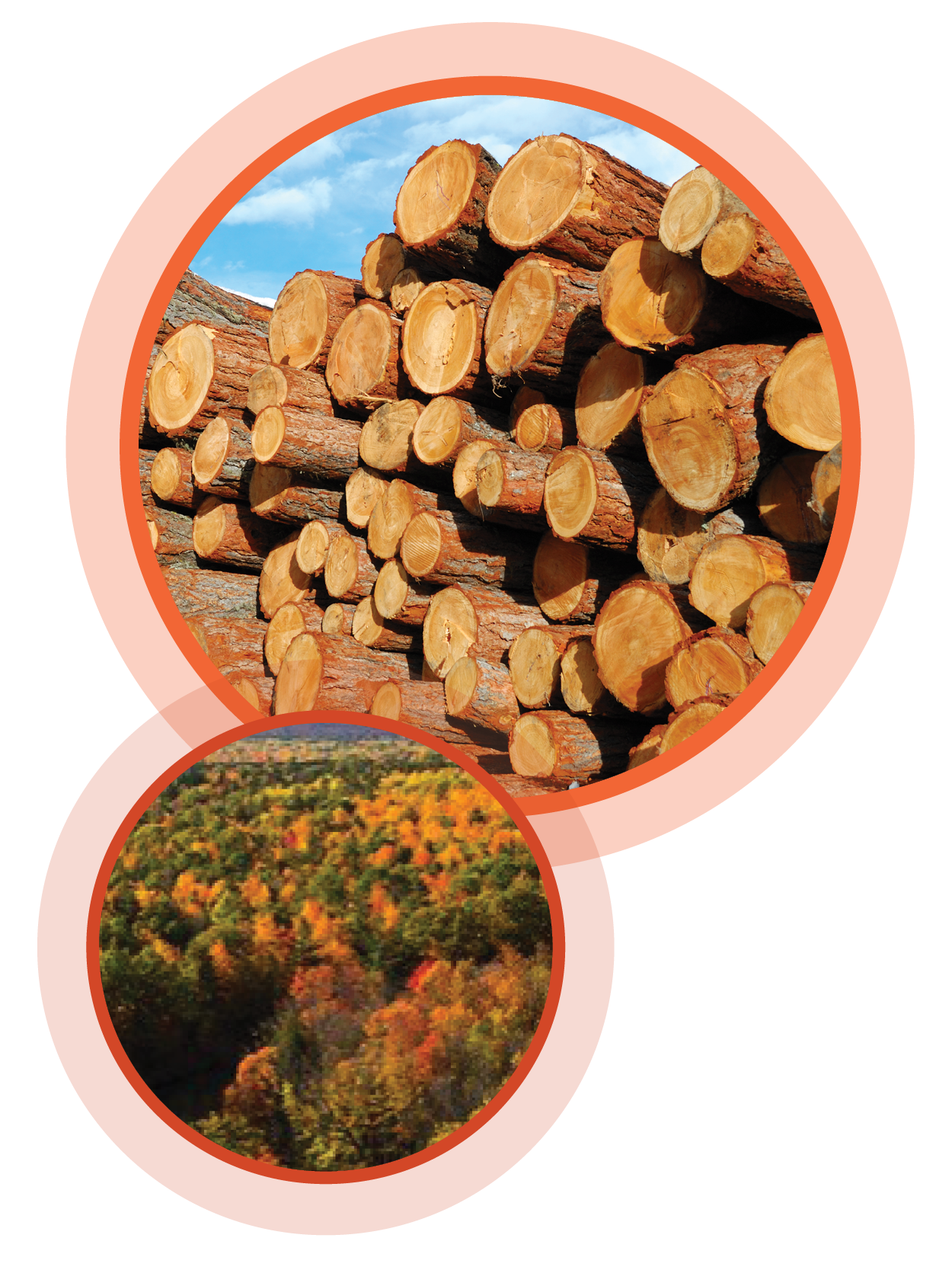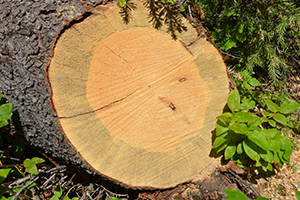 Key Concepts: The health of trees in a forest ecosystem depends on and is affected by many factors, including competition between trees and plants for space, light, water/moisture, and nutrients. [PLT’s Forest Literacy Framework, Concept 1.B.7]
Key Concepts: The health of trees in a forest ecosystem depends on and is affected by many factors, including competition between trees and plants for space, light, water/moisture, and nutrients. [PLT’s Forest Literacy Framework, Concept 1.B.7]
Objectives: Provide opportunities and materials for learners to:
- Examine cross-sections of trees.
- Infer from a tree’s growth rings what environmental conditions it might have experienced.
Session Time: 50 minutes
Setting: Indoors or Outdoors
 Every growth season, a tree adds a new layer of wood to its trunk and limbs. By counting growth rings, you can tell how old the tree or tree part was when it was cut. Each annual ring has a wide, light part Springwood (early wood) and a narrow, dark part Summerwood (late wood). In temperate climates, the early wood forms during the wet, spring growing season and late wood forms when growth slows in the fall and winter.
Every growth season, a tree adds a new layer of wood to its trunk and limbs. By counting growth rings, you can tell how old the tree or tree part was when it was cut. Each annual ring has a wide, light part Springwood (early wood) and a narrow, dark part Summerwood (late wood). In temperate climates, the early wood forms during the wet, spring growing season and late wood forms when growth slows in the fall and winter.
The rings provide clues about the area’s climate and weather over time, and evidence of environmental disturbances, such as insect pests, fires, and floods. For example, a moist spring season will produce more growth and a wider ring, while a drought or unseasonable frost will produce a narrow ring. Scars may indicate fire or other physical damage, and lopsided rings with a narrow side may indicate that the tree was crowded by another tree on that side.
Materials:
Tree cookies, large paper, marker, magnifying glasses, paper.
Get Ready:
Obtain tree cross-sections or “tree cookies” from a local tree-trimming service or other source, or make your own by sawing the trunk or limb of a fallen tree into sections 1–2 inch (4–5 cm) thick. To prevent them from splitting, dry the tree cookies either on a sunny driveway for five days or in a kitchen oven set to “warm” for five hours. Turn the cookies over periodically to dry both sides evenly. Once dry, gently sand to make the rings more visible.
Using the large paper and marker, draw a large illustration of a sample tree cookie with light and dark rings and other parts of the cross-section (see ). If possible, obtain a large tree cookie with interesting variations in its rings to share with learners.
 Introduce
Introduce
Ask: How can people tell how old a tree is? Why might it be useful to know the age of a tree? What else can we learn from tree growth rings?
Experience
- Distribute tree cookies and challenge learners to estimate how old this part of the tree was when the cookie was cut. Have them describe how they estimated the age.
- Share the enlarged tree cookie illustration you made and, as necessary, explain how to determine the age of a cross-section by counting only the light or only the dark rings. Have learners use one of these methods to determine the age of their tree cookie. Using the illustration, point out the other parts of a tree evident in a tree cookie (see illustration). Challenge learners to identify these parts on their own tree cookies.
- Explain the different kinds of markings that tree cookies display, such as scars from a forest fire, narrow rings from insect attacks or drought, etc. Discuss how various environmental conditions might present themselves in a tree cookie.
Encourage learners to identify recent environmental events in their area in the last five years, such as a hurricane or forest fire, an early or late snowstorm, or a particularly warm summer. Invite learners to create a tree cookie drawing that illustrates how these events would affect a growing tree.
Connect
Locate one or more tree stumps (or fallen trees cut to clear a trail or road) near the site. Encourage learners to analyze the tree rings visible in each stump to determine the age and growing conditions of the tree.
Point out to learners that climate scientists learn about past climate conditions by looking at tree growth rings. In warm, wet years, trees grow faster—and have wider growth rings—than in cool, dry years. Discuss: In what other ways can people use tree growth rings to learn about trees or the environment?
TAKE ACTION!
Suggest that learners search the internet for a photo of a tree cross-section timeline, which compares events in history to the life of a large, old tree. Encourage learners to determine environmental conditions the tree may have faced at different times in its life. What would they want today’s trees to show in the future?


 Key Concepts: The health of trees in a forest ecosystem depends on and is affected by many factors, including competition between trees and plants for space, light, water/moisture, and nutrients. [PLT’s Forest Literacy Framework, Concept 1.B.7]
Key Concepts: The health of trees in a forest ecosystem depends on and is affected by many factors, including competition between trees and plants for space, light, water/moisture, and nutrients. [PLT’s Forest Literacy Framework, Concept 1.B.7] Every growth season, a tree adds a new layer of wood to its trunk and limbs. By counting growth rings, you can tell how old the tree or tree part was when it was cut. Each annual ring has a wide, light part Springwood (early wood) and a narrow, dark part Summerwood (late wood). In temperate climates, the early wood forms during the wet, spring growing season and late wood forms when growth slows in the fall and winter.
Every growth season, a tree adds a new layer of wood to its trunk and limbs. By counting growth rings, you can tell how old the tree or tree part was when it was cut. Each annual ring has a wide, light part Springwood (early wood) and a narrow, dark part Summerwood (late wood). In temperate climates, the early wood forms during the wet, spring growing season and late wood forms when growth slows in the fall and winter. Introduce
Introduce